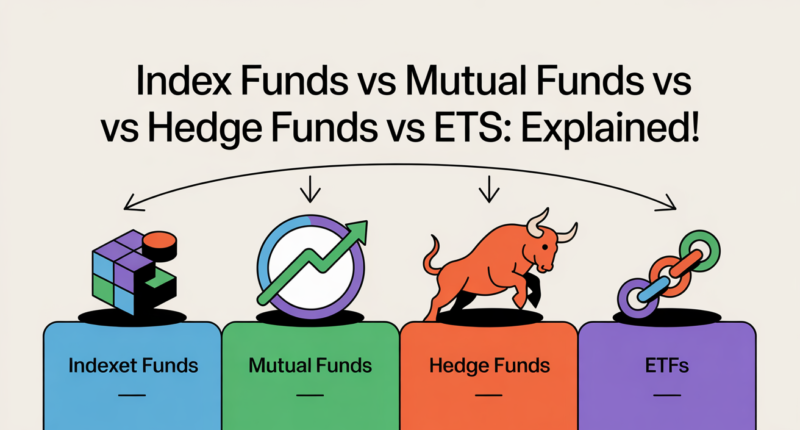Investing often involves pooled funds such as index funds, mutual funds, ETFs, and hedge funds.
Meanwhile, each fund type has different features:
-
Index funds passively track market benchmarks
-
Mutual funds are actively managed by professionals
-
ETFs trade on stock exchanges like stocks
-
Hedge funds use aggressive strategies for potentially higher returns.
For finance students and experienced investors alike, understanding these differences is crucial.
Index Funds: Passive Market Trackers

Index funds, as explains, are funds (mutual or ETF) designed to track a market index. This means they mirror an index, so they are passively managed and charge very low fees. Investors often favor index funds for broad diversification and predictability.
Importantly, index funds are open to all investors.
Mutual Funds: Actively Managed Pools
Mutual funds pool money from many investors into diversified portfolios of stocks and bonds. A professional manager runs the fund and tries to beat the market. However, active management means mutual funds often charge higher fees. They also diversify investments to reduce risk. One drawback is that mutual funds trade once per day, so you cannot buy or sell instantly.
Exchange-Traded Funds (ETFs): Funds on the Market
Many investors compare mutual funds and ETFs. Both pool investor money , but ETF shares trade on exchanges throughout the day while mutual fund shares trade only once per daywealth.visualcapitalist.com. Many ETFs also track market indexes for easy diversification. Importantly, ETFs usually have lower fees than mutual funds and disclose holdings daily. However, frequent trading of ETFs can incur extra costs or tax consequences.
Hedge Funds: High Risk, High Reward
Hedge funds are private investment funds that use a variety of strategies (including leverage and derivatives) to seek high returns. Consequently, they often invest in exotic assets like real estate, commodities, or start-ups. Typically, only accredited investors (wealthy individuals or institutions) can invest in hedge fund. Hedge funds charge high fees (often 2% of assets plus 20% of profits) and take on high risk. For this reason, they suit only the most experienced or institutional investors.
Pros and Cons of Each Fund
-
Index Funds
Pros: Very low fees and broad exposure.
Cons: Can only match market returns and will fall when the market does. -
Mutual Funds
Pros: Professional management.
Cons: Higher fees, variable performance, and end-of-day trading
assurancewealthmanagement.com. -
ETFs
Pros: Trades during market hours and low expense ratios.
Cons: May incur trading commissions and tracking errors. -
Hedge Funds
Pros: Potential for high returns and unique diversification strategies.
Cons: Very high fees and risk; only open to accredited investors
smartasset.com.
Conclusion
Ultimately, the right fund depends on your goals and risk tolerance. Index funds and ETFs offer market exposure at low cost. Mutual funds aim to outperform but charge higher fees. Hedge funds target high returns but carry higher risk and are usually only open to accredited investors. Understanding these differences can help you choose the right fund.









